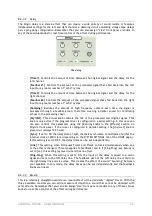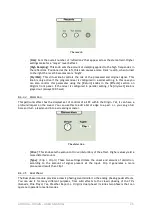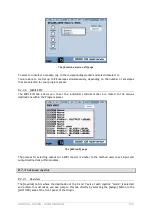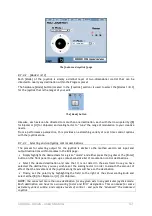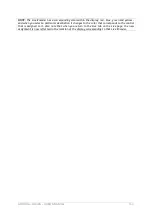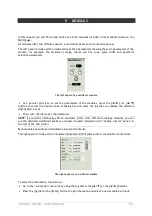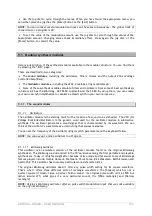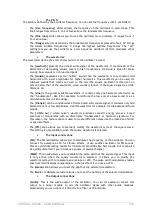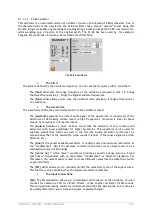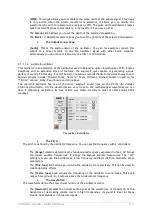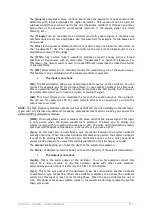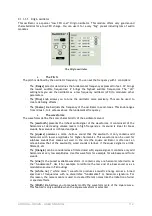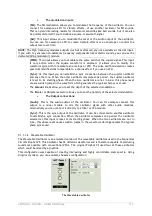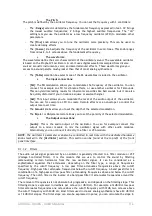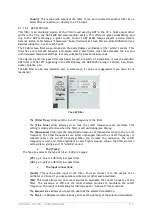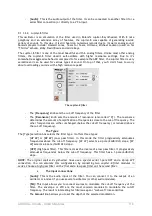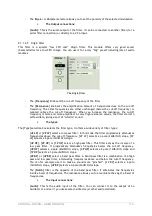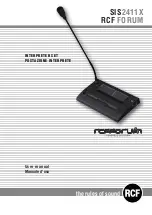
ARTURIA – ORIGIN – USER’S MANUAL
108
•
The Pitch:
The pitch is defined by the oscillator frequency. You can set the frequency with 3 controllers:
-
The [
Osc. frequency
] slider adjusts the frequency of the oscillator in semi-tones. This
knob ranges from minus 2, to 2 octaves above the fundamental frequency.
-
The [
Fine
tune
] slider allows you to tune the oscillator more precisely. It ranges from -1
to +1 semitone.
-
The |
Range
] selector determines the fundamental frequency expressed in feet. 32’ brings
the lowest audible frequencies; 4’ brings the highest audible frequencies. The “LO”
setting lets you use the oscillator as a low frequency oscillator (LFO) to modulate other
parameters.
•
The waveforms:
The waveforms define the sonic characteristic of the oscillator’s sound.
-
The [
sawtooth
] presents the richest audio signal of the waveforms. It contains all of the
harmonics at decreasing volume levels in high frequencies. Its sound is ideal for brass
sounds, bass sounds or rich lead and pads.
-
The [
square
] possesses a more “hollow” sound than the sawtooth. It only contains odd
harmonics with lower amplitudes for higher harmonics. This waveform can be used for
sub-bass sounds that comes out well in the mix (the square oscillator is often set an
octave below that of the sawtooth), wood sounds (clarinet, if the square signal is a little
filtered), etc.
-
The [
sine
] is the purest available waveform. It contains only one harmonic referred to as
the “fundamental”. Use it for example to reinforce the low end of a bass sound or as a
modulation source in FM routings.
-
The [
triangle
] can be considered as a filtered (and soft) square signal. It contains only odd
harmonics at very low amplitudes. Use this waveform for example for sub basses and flute
sounds.
-
The
[white no
] (“white noise”) waveform produces acoustic energy across a broad
spectrum of frequencies with no discernible “fundamental” or harmonic signature. For
this reason, the noise module is used to create different noises like the imitation of wind
or special effects.
-
The [
PW
] knob allows you to manually modify the waveform cycle of the square wave.
This setting is only available when the square waveform is selected.
•
The Input connections:
-
[
FM
]: The FM modulation allows you to modulate the frequency of the oscillator. You can
connect for example a LFO for vibrato effects, or use another oscillator for FM sounds.
This can yield interesting results for inharmonic sonorities like bell sounds, but it can also
be quickly distorted if you introduce a square or sawtooth signal.
-
[
PWM
]: This input allows you to modulate the pulse width
of the square signal. This input
is only active when the square waveform is selected. It allows you to modify the
waveform cycle with for example an envelope or LFO. The pulse width modulation creates
spectrum modifications comparable to a chorus effect if you use an LFO.
-
The
Amount
knob allows you to set the depth of the selected modulation.
-
The
Bi
polar or
Uni
polar selector allows you to set the polarity of the selected modulation.
•
The Output connections:
-
[
Audio
]
:
This is the audio output of the oscillator
.
You can for example connect this
output to a mixer module to mix the oscillator signal with other audio modules.
Alternatively you can connect it directly to a filter or VCA module.

